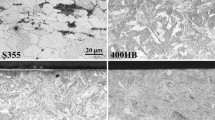Abstract
The relatively newer high Cr martensitic steels such as P91 have now been in use in power industry for over twenty years. Over this time, there have been a number of incidents of cracking and failure in components made from P91 steel, both in thick and thin section equipments mainly due to creep damage. The thick section components have been usually failing due to Type IV cracking associated with the weldments while thin section components have been failing due to higher than expected levels of steam oxidation resulting in enhanced metal loss, increase in metal temperature above design, creep cavitation and cracking. However, it has not been possible to detect early stage creep damage/cavitation in high Cr martensitic steels using conventional replication type methods. This is because unlike the low alloy CrMoV steels, spherodisation of microstructure does not occur in high Cr martensitic steels and cavitation clearly visible by traditional methods only appears later in life when the material is about to fail. Thus there has been a need to develop new tools and more sensitive methods for integrity and damage assessment in these steels. European Technology Development (ETD) together with its industrial collaborators from Europe, Japan and North America have been looking at the development of tools and methodologies for early stage damage detection and life prediction as a part of its international multi-client project ‘P91 Integrity’. The tools which have shown successful results are portable Scanning Force Microscopy, laser guided hardness tester and more innovative use of ultrasonic probes for detecting early stage creep damage. This paper discusses the issues involved and describes some of the developments in this project.
Similar content being viewed by others
References
Shibli I A, Robertson D G, Review of the use of new high strength steels in conventional and HRSG boilers: R&D and plant experience, ETD Report No: 1045-gsp-40, October 2006.
Middleton C, Metcalfe E, A review of laboratory Type IV cracking data in high chromium ferritic steels, Paper C386/027, Published in IMechE Proceedings, London, 1990.
Brett S J, Allen D J, Pacey J, Failure of a modified 9Cr header endplate, Proc. Conf. Case Histories in Failure Investigation, Milan, (1999) 873.
Allen D J and Brett S J, Premature failure of a P91 header endcap weld: minimising the risks of additional failures, Proc. Conf. “Case Histories in Failure Investigation”, Milan, (1999) 133
Brett S J, Identification of weak thick section modified 9Cr forgings in service, Proc. Swansea Creep Conference, Swansea, UK, April 2001.
Brett S J, The creep strength of weak thick section modified 9Cr forgings, Proc. Conf. Baltica V, 1 (2001).
Brett S J, In-Service Type IV Cracking in a Modified 9Cr (Grade 91) Header, Proc. ECCC Creep Conference, London, Sep. 2005, Proceedings published by ETD Ltd.
Allen D J, Harvey B and Brett S J, FOURCRACK — An investigation of the creep performance of advanced high alloy steel welds, Proc. ECCC Creep Conference, Sep. 2005, Proceedings published by ETD Ltd.
V&M Tubes, France, Private communications.
Pearson M, Anderson R W, Measurement of damaging thermal transients in F-Class horizontal HRSGs, Proc. Intl. Seminar Cyclic Operation of Heat Recovery Steam Generators, 24 June 2005, London, UK, Published by European Technology Development.
Lutfibin Samsudin M, Experience with HRSG T91 tube failures, Proc. Intl. Seminar Industry & Research Experience in the Use of P91/T91 in HRSG and Conventional Boilers, 7–8 Dec 2005, London, UK, Published by European Technology Development.
Scully S, ESB, Ireland, New High Temperature Materials Seminar, London, 10–11 Sep. 2008.
Edmund W K Chang and Robert M Clark, T91 secondary superheater tube failures investigation, Hawaiian Electric Company, Inc., Honolulu, Hawaii.
Ennis P J and Quadakkers W J, 9–12% Cr steels: Application limits and potential for further development, Published in the Proceedings of the Fifth Charles Parsons Conference on Advanced materials for 21st century turbines and power plant, held at Churchill College, Cambridge, UK, on 3–7 July 2000, Published by Institute of Materials, London.
Masuyama F, Integrity and life assessment of P91 components, Proc. Intl. Seminar Industry & research experience in the use of P/T91 in HRSGs/boilers, Published by European Technology Development.
Chan-Seo Jeong, Si-Yeon Bae and Byeong-Soo Lim, The effect of cavity on the creep fracture in P92 and P122 steels and its detection by intelligent phased array ultrasonic, School of Mechanical Engineering, Sungkyunkwan University, Kyonggi-do, Korea.
Author information
Authors and Affiliations
Corresponding author
Rights and permissions
About this article
Cite this article
Shibli, A. Remaining life assessment issues in high Cr martensitic steels and development of new innovative tools for damage monitoring and integrity assessment. Trans Indian Inst Met 63, 339–348 (2010). https://doi.org/10.1007/s12666-010-0045-6
Received:
Revised:
Accepted:
Published:
Issue Date:
DOI: https://doi.org/10.1007/s12666-010-0045-6




